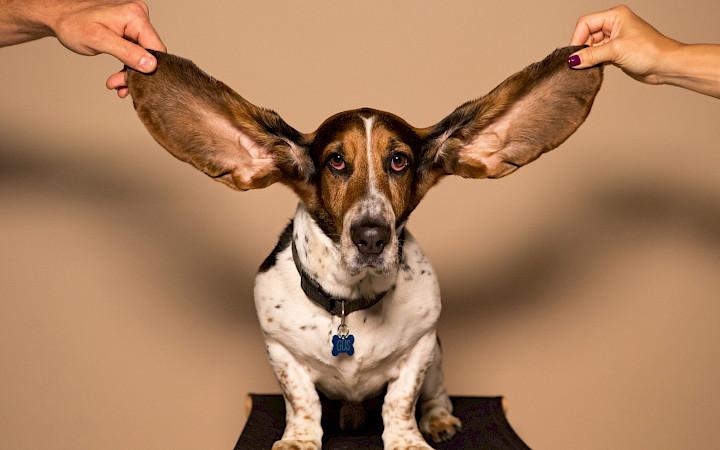
A few weeks ago, I wrote about the physical and communication aspects of dog tails. Today, I thought it would be fun to explore dog ears.
I must confess that the soft floppy ears of Labrador retrievers are one of my favorite things about them. A 14-year old Lab can look like a puppy when he perks up his ears, cocks his head, and stares lovingly at a cookie. Like tails, dog ears have their own tale to tell.
Fun dog ear facts:
- As you know, some breeds have pointed ears, some have really long floppy ears, and others have ears that are sort of in between. In general, dogs hear four times better than people. So you may not hear anything in the middle of the night, but when you dog starts barking, rest assured he does. They also hear at a higher decibel range than humans. Hence, the dog whistle and those toys that supposedly squeak out of her hearing range!
- A dog’s ears move independently of one another. Each ear has about 18 muscles in it that allow it to move in so many ways. (Humans have six.) You’ve probably seen a German Shepherd Dog have one ear pricked forward and another turned behind him. This allows him to hear from both directions.
- Regardless of the shape of the exterior ear flaps, called pinna, when sound gets inside a dog’s ear, the L-shaped ear canal magnifies the sound. Of course, the L shape can also be problematic for keeping water, dirt, wax, and debris in the ear, which can make them prone to ear infections.
- Ears aren’t just for hearing! Notice how long a hound’s ears are? Those long flaps help scoop up and magnify the smells on the ground so that they can smell better and track prey and people!
- What’d you say? Anybody who lives with a dog has seen how they communicate with their ears! Ears pricked forward and they’re usually interested in something. Ears pressed back against their skull, and they are likely feeling insecure or aggressive. Other dogs, not just people, can read those signals just like they can read a fellow dog’s tail movement.
- Like docked tails, docked ears are not only cruel to the dog, they interfere with their ability communicate. The reasons for docking dog ears in the past ranged from getting rid of a part that other dogs or animals could hold on to or injure to aesthetics. Neither reason is valid and hurts, not helps dogs.
- A dog’s ears have a huge concentration of nerve endings, making them one of the most sensitive parts of a dog’s body. Did you know that gently running your fingers down the middle and edges of a dog’s ears can have a great calming effect because their ears are full of acupressure points? Only their bellies and in between their toes have so many nerve endings! So yes, dogs like to have their ears gently rubbed and it usually has as calming effect on them.
- Dog’s ears emit pheromones! That’s why dogs often sniff each other’s ears when they meet. There’s a lot of info in those ears for another dog to make sense of.
All our body parts have a function, and dogs’ bodies are no different! No matter how quietly you say. “time for walkies,” chances are your dog is going to hear you!